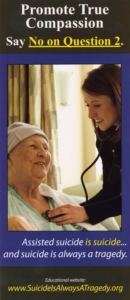The slippery slope of assisted suicide
Proponents of physician-assisted suicide tell us that there is no danger of a slippery slope, that in Oregon the cases are "not that numerous" and are "carefully monitored." I hope that reasonable people will question these claims and reflect further on whether a law with insufficient safeguards is what we want in the commonwealth.
Slippery slope arguments involve small decisions that lead to undesirable outcomes that never would have been supported at the outset. Often, it is impossible to prove that one small step will have significant negative effects, but common sense allows reasonable people to judge the likelihood that a sequence of events that have happened in one place are likely to happen in another place in a similar way.
Question 2 proposes to allow physician-assisted suicide for those diagnosed with a terminal illness with six months or less to live. Many groups are concerned that, if passed, it not only would be harmful in itself, but could lead to unintended tragic outcomes. (1) Elder advocates are concerned that it could become a new form of elder abuse. (2) Advocates for the disabled are concerned it could lead to "quality of life" standards in our society, where those with a lower perceived quality of life receive fewer benefits or protections. (3) Doctors and nurses are concerned it could lead to a lower "quality of care" for those at the end of life. (4) Doctors are also concerned that it could undermine the doctor-patient relationship. (5) Ethicists are concerned that it could lead to a devaluing of human life. (6) Suicide-prevention organizations are concerned that the state legally allowing suicide for one group (those with terminal diagnoses of fewer than six months to live) could lead to increased suicide rates for the rest of the population. (7) Those who have studied the evolution of this matter in the Netherlands are concerned that assisted suicide could lead, first to voluntary euthanasia (requesting direct help to end one's life), and then to involuntary euthanasia (where a third-party determines that, if the patient were in his right mind, he would choose euthanasia).
Asserting that something could happen is not the same as stating that something will happen. Here are some facts that lead the groups above to be concerned. Please judge for yourself whether you agree with the risk that one or all of these concerns might occur in Massachusetts if we took the first step this Election Day by voting to legalize assisted suicide.
It could lead to increased elder abuse: Data on the crime of elder abuse show that perpetrators are frequently a spouse or an adult relative. Question 2 does not have safeguards to prevent an unscrupulous heir or indifferent family member from pressuring a sick person, either directly or in subtle ways, to end his or her life. That hardly gives sick people "greater freedom" and "enhanced autonomy" at the end of their lives.
It could lead to adoption of "quality of life" standards: Advocacy groups for the disabled are concerned that a policy of assisted suicide will inevitably lead to establishing social standards of acceptable life. When "quality of life" becomes more important than life itself, the mentally ill, the disabled, the depressed, and those who cannot defend themselves will be at risk of being targeted for assisted suicide, and perhaps eventually, for euthanasia. They fear that misunderstandings and false compassion could result in their being considered "better off dead," devalued, and treated as second class citizens in respect to their medical care.
It could lead to lower quality of care: Doctors' and nurses' groups have expressed concern that efforts to enhance hospice and palliative care will be weakened if a "lazy" path to end-of-life care like physician-assisted-suicide is chosen by voters. They share grave concerns that medical cost-containment pressures will lead to a preference for a $100 prescription for lethal drugs over more expensive treatments.
It could undermine the doctor-patient relationship: The American Medical Association (AMA) and Massachusetts Medical Society oppose physician assisted suicide because it violates the Hippocratic Oath to "do no harm" and changes the nature of the doctor's role of healing and comforting the patient. The AMA stated "Physician-assisted suicide is fundamentally incompatible with the physician's role as healer, would be difficult or impossible to control, and would pose serious societal risks." The goal of medicine is to heal and to cure and, where that is not possible, to comfort the patient. Doctors are expected to act always in the best interests of the patient. Dr. Leon Kass, former chair of the President's Council on Bioethics, asks the following common sense question: "Will doctors be able to care wholeheartedly for patients when it is always possible to think of killing them as a 'therapeutic option?'" In Holland, reports have been published documenting the sad fact that elderly patients, out of fear of euthanasia, refuse hospitalization and even avoid consulting doctors. Dutch citizens have begun to fear that their doctors, instead of being caregivers, will become their executioners.
It could lead to a devaluing of human life: "Taking life in the name of compassion also invites a slippery slope toward ending the lives of people with non-terminal conditions. Dutch doctors, who once limited euthanasia to terminally ill patients, now provide lethal drugs to people with chronic illnesses and disabilities, mental illness, and even melancholy. Once they convinced themselves that ending a short life can be an act of compassion, it was morbidly logical to conclude that ending a longer life may show even more compassion. Psychologically, as well, the physician who has begun to offer death as a solution for some illnesses is tempted to view it as the answer for an ever-broader range of problems." (USCCB, To Live Each Day with Dignity)
It could lead to an increase of suicide generally: Oregon, the first state to legalize physician-assisted suicide, has one of the highest rates of suicide (not including deaths from PAS) of any state in the nation. It begs a logical question: How can a state effectively both try to minimize suicide in some situations and promote it as a legal alternative in other situations? Is it reasonable to expect that efforts to prevent suicides will be undermined by legalizing suicide and presenting it as normal and acceptable for those with terminal diagnoses?
It could lead, eventually, to euthanasia -- like it has in the Netherlands: It is very sobering to see the evolution of physician-assisted suicide in the Netherlands, a modern industrialized country. In 1973 the "Right to Die -- NL" was founded and euthanasia has been legal in the Netherlands for more than a decade. The New York Times reported in their April 3, 2012, edition that "Right to Die -- NL" is campaigning for expanded euthanasia, in the form of mobile teams to go out to people's homes to euthanize them. They are also promoting the idea that euthanasia should no longer be limited just to the terminally ill, and their proposal envisions the service for any individual over 70 years of age who requests it.
The Dutch patients' organization, NPV, strongly criticizes the current application of the law, saying the practice of euthanasia has been extended to include patients with dementia and other conditions who may not, by definition, be competent to request help in dying, including children. Elise Van Hock-Burgerhart, a spokeswoman for NPV, told the New York Times reporter that the idea of mobile euthanasia teams was a matter of concern because there was no way for the mobile team doctors to get to know the patients. Moreover, she stated that research in the Netherlands indicated that requests for euthanasia from the elderly would be substantially reduced if palliative care were better in their country and that the country should be working toward improving palliative care, not increasing euthanasia. She also indicated that the law in the Netherlands required review committees to sign off on every reported case of euthanasia, but that 469 cases from 2010 had still not been reviewed; 2010 is the latest year for which data is available. That year 3,136 notifications of termination of life on request were reported, indicating that it was not clear how well doctors were adhering to the official guidelines. Anyone that believes that a "slippery slope" doesn't exist with assisted suicide and euthanasia only has to look at its "evolution" in the Netherlands.
In the United States we are still a long way from the Dutch situation; however, this is not because the laws in the two states that allow PAS are well written or because of careful oversight. What has put the brakes on the growth of physician-assisted suicide in the U.S. is that more than 20 states have rejected proposed legislation and ballot initiatives.
Now it is our turn in Massachusetts to stop this bad idea and bad law from going into effect. Please join me to stop assisted suicide by voting "No on Question 2" on Election Day.
The Archdiocese of Boston has developed an educational website on the Church's teachings on end of life issues, www.SuicideIsAlwaysATragedy.org. The archdiocese is also part of a large coalition of groups from other faiths, from the medical community, and from disabilities rights groups that are advocating a no vote on Question 2. The coalition's website is www.StopAssistedSuicide.org.



















